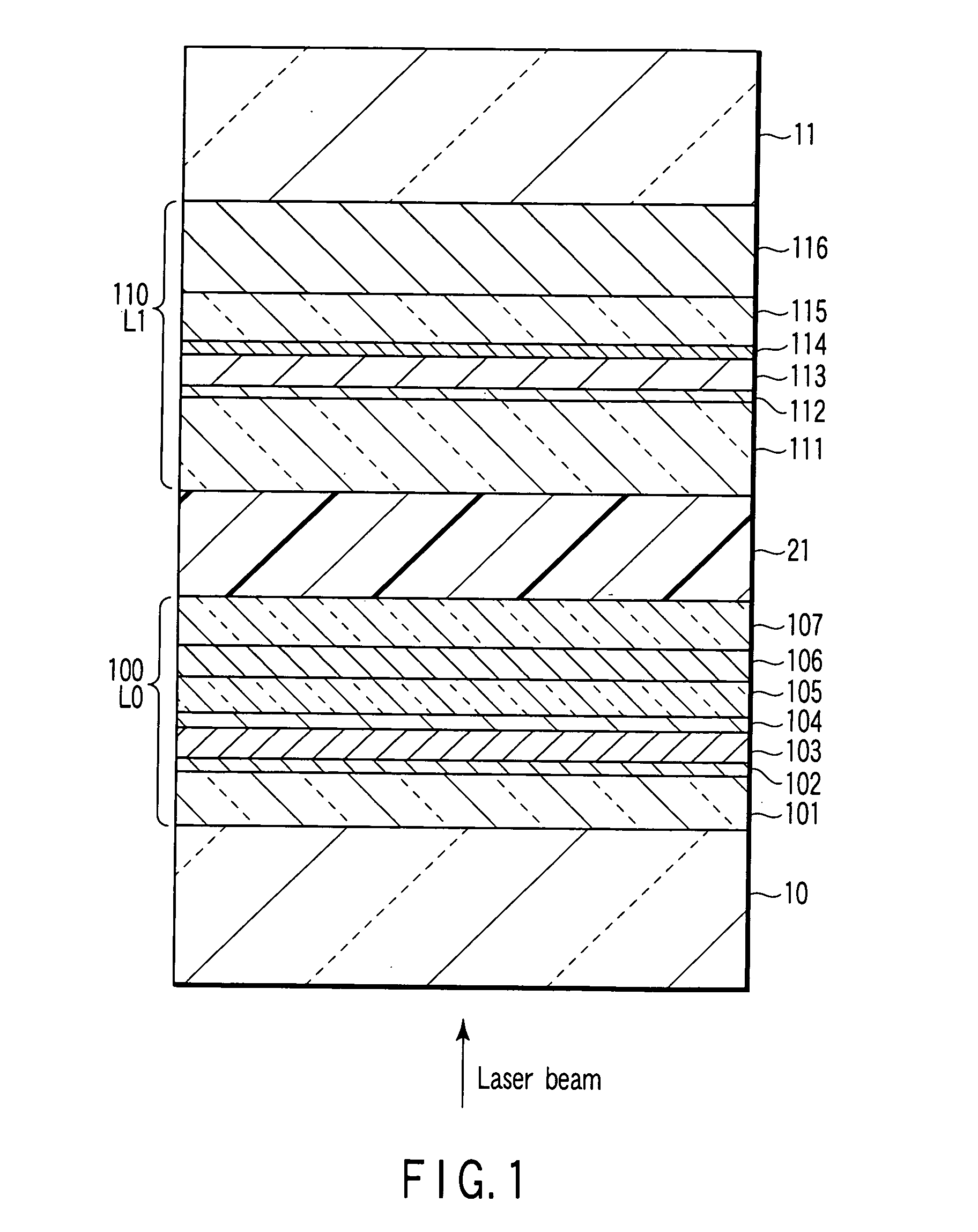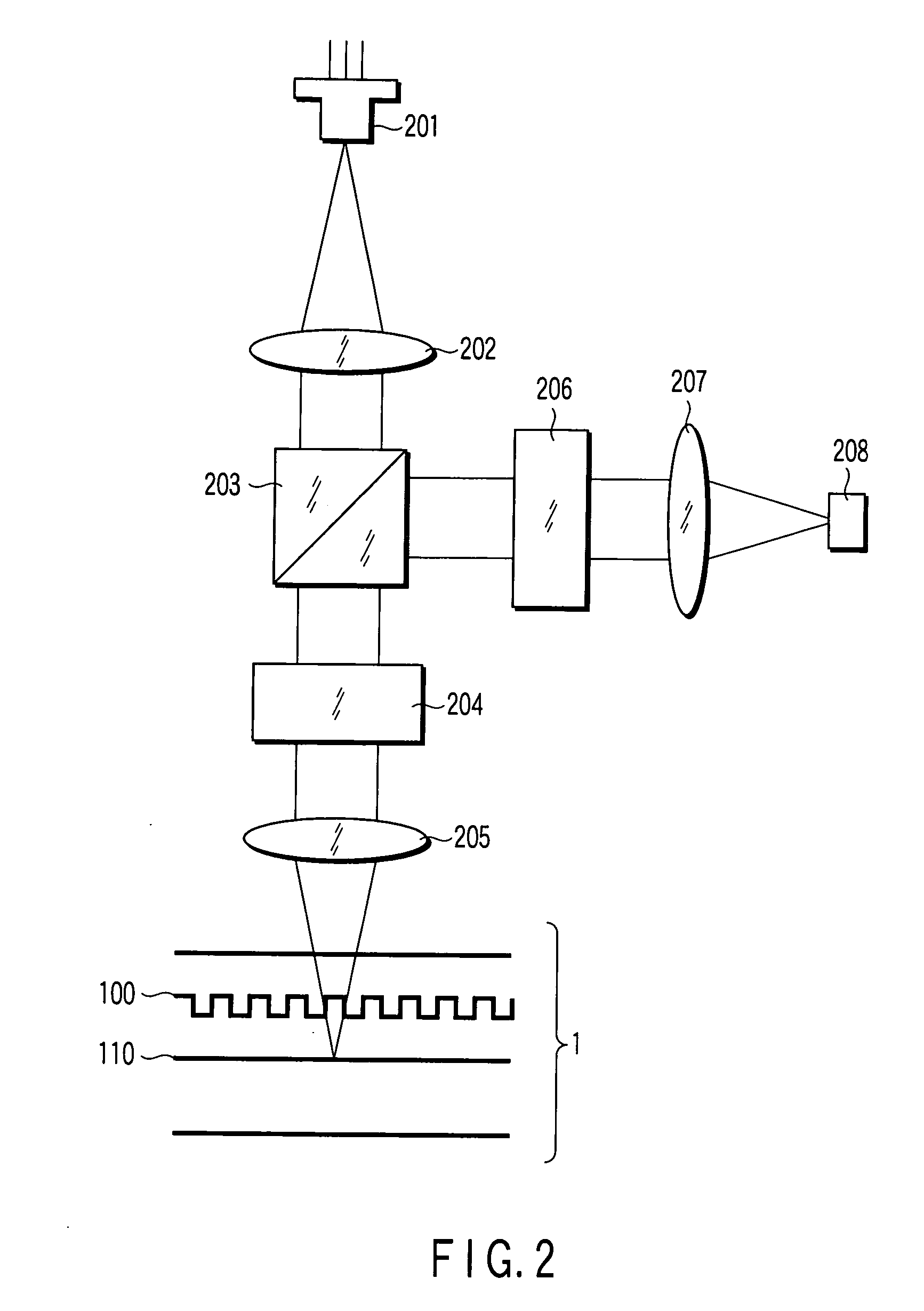Phase-change optical recording media and optical recording-reproducing apparatus
a technology of optical recording media and optical recording recording equipment, which is applied in the direction of mechanical recording, record information storage, instruments, etc., can solve the problems of information in a certain track deteriorating, so-called cross-erase problems, and errors in the stage of converting signals into digital data
- Summary
- Abstract
- Description
- Claims
- Application Information
AI Technical Summary
Benefits of technology
Problems solved by technology
Method used
Image
Examples
example 1
[0043] In the present Example, a single-sided, dual-layer media is prepared by using a grooved substrate for the L0 layer and a mirror substrate for the L1 layer, and both the information layers are reproduced based on reflectance difference.
[0044]FIG. 1 is a cross-sectional view showing the optical recording media in the present Example. The substrate 10 for the L0 layer 100 and the substrate 11 for the L1 layer 110 are polycarbonate (PC) substrates prepared by injection molding and having a thickness of about 0.58 mm. Grooves are formed at a pitch of 0.76 μm on the substrate 10 for the L0 layer 100 positioned close to the light incident side. In performing land / groove recording, the track pitch corresponds to 0.38 μm. A so-called mirror substrate that is flat and not having grooves is used as the substrate 11 of the L1 layer 110 positioned remote from the light incident side.
[0045] The L0 layer 100 is prepared by depositing, on that surface of the substrate 10 on which grooves a...
example 2
[0060] In the present Example, a single-sided, dual-layer media is prepared by using a mirror substrate for the L0 layer and a grooved substrate for the L1 layer. The L0 layer is reproduced based on reflectance difference and the L1 layer is reproduced based on phase difference.
[0061]FIG. 3 is a cross-sectional view showing the optical recording media in the present Example. The substrate 11 for the L0 layer 100 and the substrate 10 for the L1 layer 110 are polycarbonate (PC) substrates prepared by injection molding and having a thickness of about 0.58 mm. A so-called mirror substrate that is flat and not having grooves is used as the substrate 11 of the L0 layer close to the light incident side. Grooves are formed at a pitch of 0.76 μm on the substrate 10 for the L1 layer positioned remote from the light incident side. In performing land / groove recording, the track pitch corresponds to 0.38 μm.
[0062] The L0 layer 100 is prepared by depositing, on that mirror surface of the substr...
example 3
[0067] In the present Example, a single-sided, triple-layer media is prepared in which reproduction based on reflectance difference and reproduction based on phase difference are employed in combination.
[0068]FIG. 4 is a cross-sectional view showing the optical recording media in the present Example. The substrate 10 for the L0 layer is a polycarbonate (PC) substrate prepared by injection molding and having a thickness of about 0.58 mm on which grooves are formed at a pitch of 0.76 μm. In performing land / groove recording, the track pitch corresponds to 0.38 μm. The L1 layer remoter than the L0 layer as viewed from the light incident side is formed as a flat information layer on a substantially flat interlayer separating layer 22 without grooves formed on the L0 layer by the 2P method. The substrate 12 for the L2 layer remoter than the L1 layer as viewed from the light incident side is a polycarbonate (PC) substrate prepared by injection molding and having a thickness of about 0.58 ...
PUM
| Property | Measurement | Unit |
|---|---|---|
| transmittance | aaaaa | aaaaa |
| thickness | aaaaa | aaaaa |
| thickness | aaaaa | aaaaa |
Abstract
Description
Claims
Application Information
 Login to View More
Login to View More - R&D
- Intellectual Property
- Life Sciences
- Materials
- Tech Scout
- Unparalleled Data Quality
- Higher Quality Content
- 60% Fewer Hallucinations
Browse by: Latest US Patents, China's latest patents, Technical Efficacy Thesaurus, Application Domain, Technology Topic, Popular Technical Reports.
© 2025 PatSnap. All rights reserved.Legal|Privacy policy|Modern Slavery Act Transparency Statement|Sitemap|About US| Contact US: help@patsnap.com



